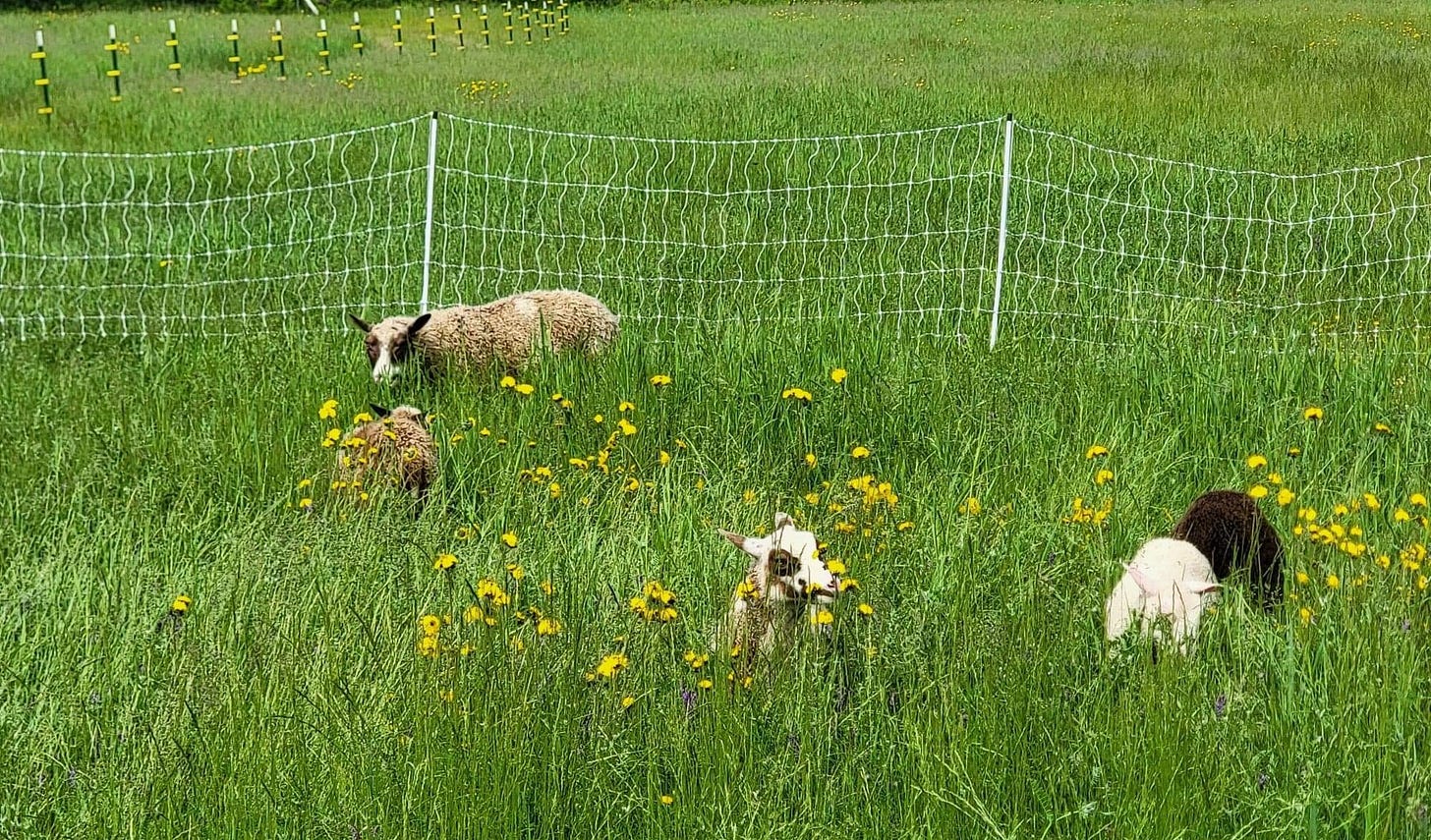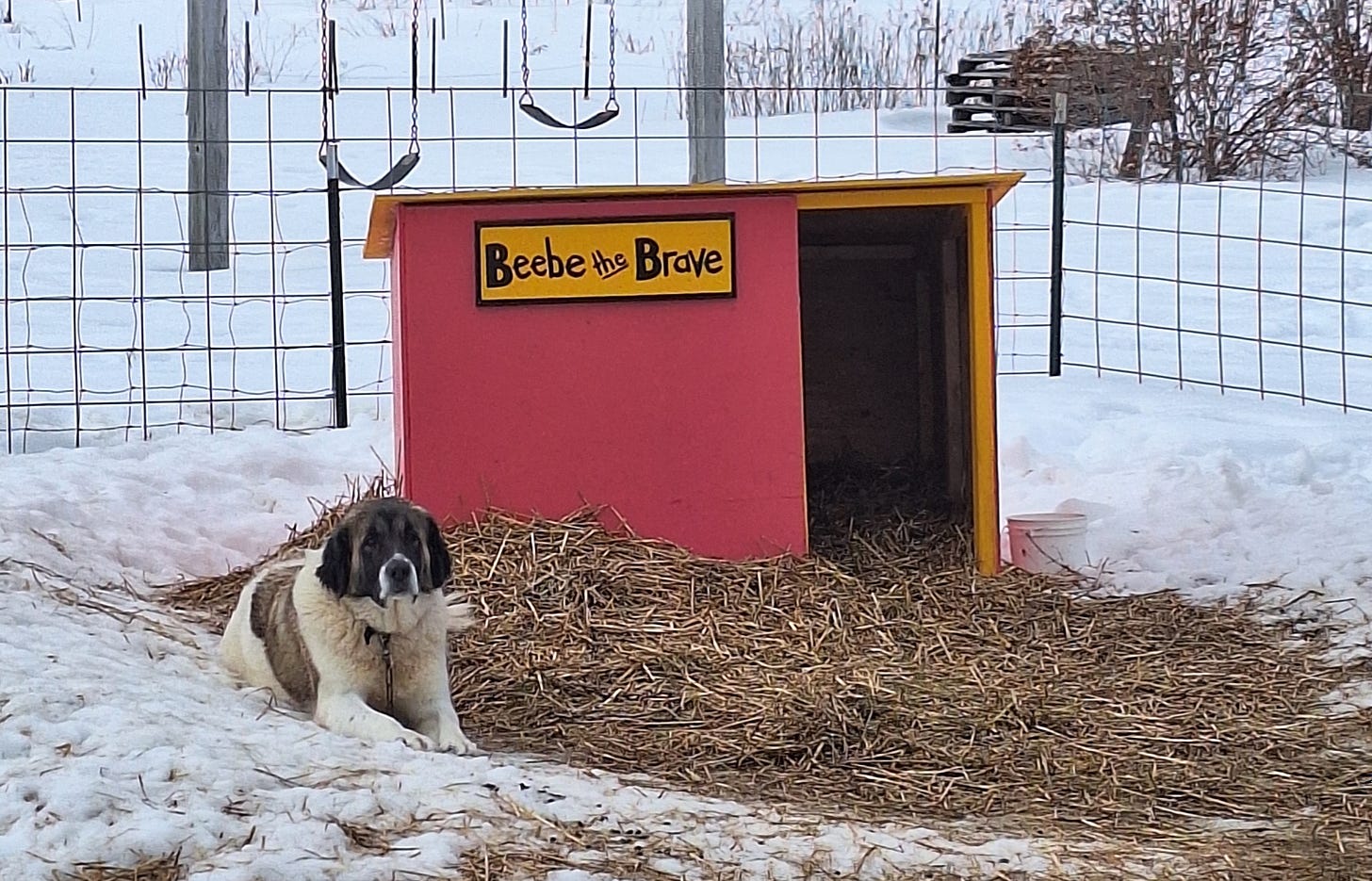Beebe looked at me balefully from her doghouse and I couldn’t help the rueful chuckle that escaped me. I’ve been feeling antsy, too, this past week, though I have plenty to keep me busy. Seed-sowing, cleaning spaces inside the farmhouse that might not see another cleaning till next winter, preparing for lambing─and writing─fill my days. The change of pace has allowed for much needed rest and recuperation, but I think Beebe would agree that nothing quite beats those glorious afternoons on the field.
Welcome to the latest Updates From the Farm! If you are new here, I invite you to check out my About page to learn what this is, who I am and why I am doing this. Or just dive right in! At “Runamuk Acres” you’ll find the recantings of one lady-farmer and tree-hugging activist from the western mountains of Maine. #foodieswanted
Wool or Meat?
When people ask, as they inevitably do, if we use our sheep for wool or for meat, they are always surprised when I respond, “Neither.”
Our sheep are the rock stars of our conservation efforts here at Runamuk Acres. They’re part of my effort to remediate the poor soil and forage conditions of our 10-acre field, thereby improving the habitat for local wildlife
By practicing rotational grazing with my small flock of finnsheep, I’m not only adding fertilizer to the soil, but also stimulating the plants on the field to grow more vigorously, too. To do this, you have to manage rotations diligently to prevent overgrazing, moving the sheep when they’ve consumed about half the vegetative material.
What is rotational grazing?
A system of grazing where animals are introduced to new feed on new paddocks on a frequent basis. Animals are confined to relatively small paddocks to maximize efficiency in grazing. In this system, high quality forage is rationed out to meet livestock needs, while plants that have recently been grazed are protected from being eaten again until they have adequately recovered. By managing animal access to forage, you are managing plant growth and plant health.
Still building up my infrastructure here, I’m using electric net fences tethered to a line of semi-permanent fencing that runs through the middle of my field. With 2 separate groups of sheep─males vs females─and each group with their own “sheep-tractor” (a moveable shed that’s dragged across the field with a heavy-duty utility dolly), supplement feeder and watering trough, it’s quite a job to move them.
How frequently I move them depends on the number of sheep in the group and how fast the grass is growing. Sometimes I’m moving a group of sheep every 3 or 4 days, other times it can be as long as 10-14 days before they’ll require moving.
And where the sheep go, Beebe goes too.
Beebe the Brave
A central asian shepherd weighing in at more than 100 pounds, Beebe the Brave lives with the sheep to protect the flock from our Western Maine predators. With black bears, coyotes, bobcats, and even owls and eagles that would make a meal of a small lamb, it’s a huge comfort knowing that Beebe is on the field with her big and insistent bark.
It was the name she came with, and had I not googled the meaning of it, I would have changed it when we brought her home. Pronounced “Bee-Bee”, Beebe is an old English name meaning: the place where bees are kept. Having built my farm-business on beekeeping, this seemed appropriate and so it stuck.
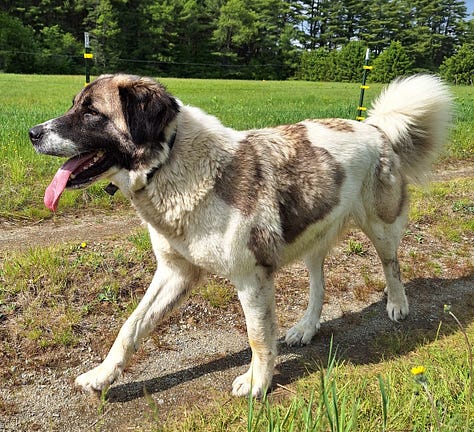
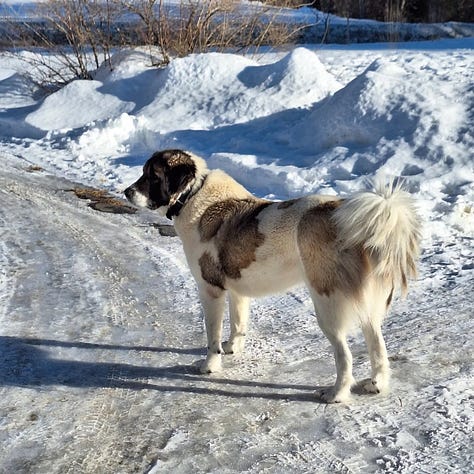
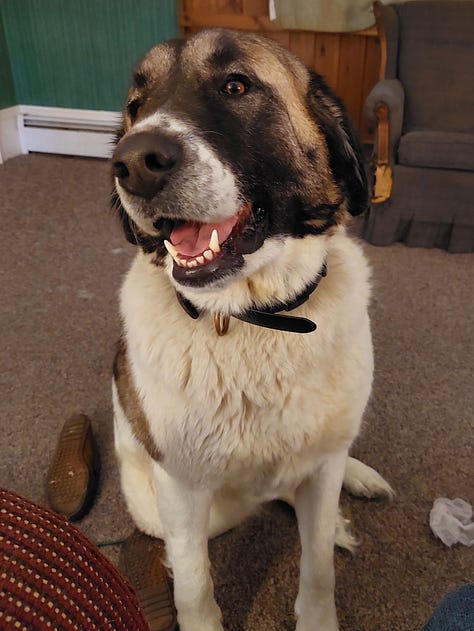
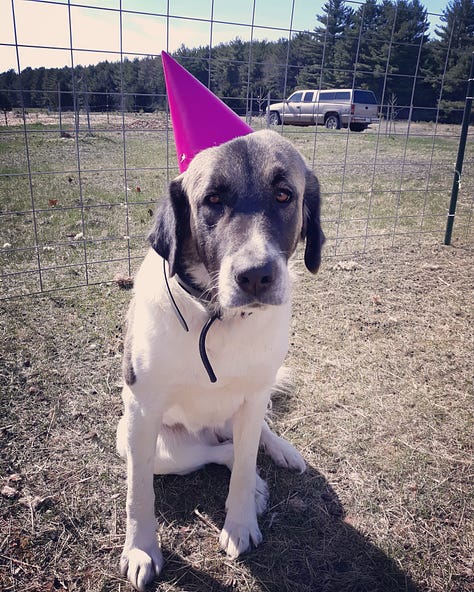
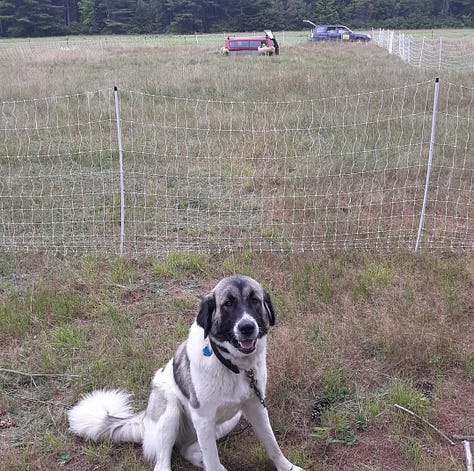
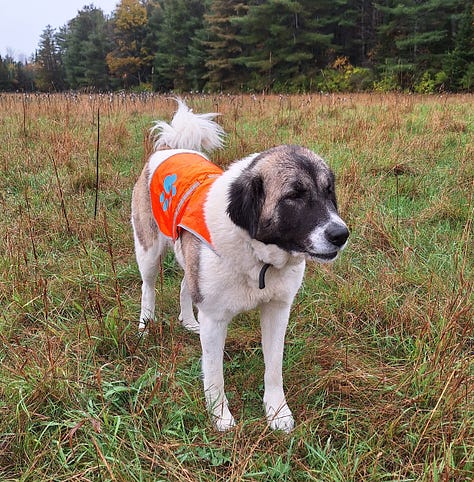
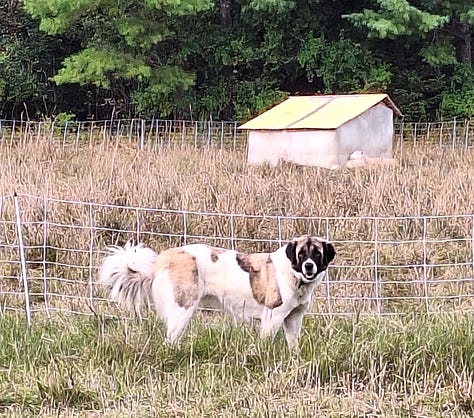
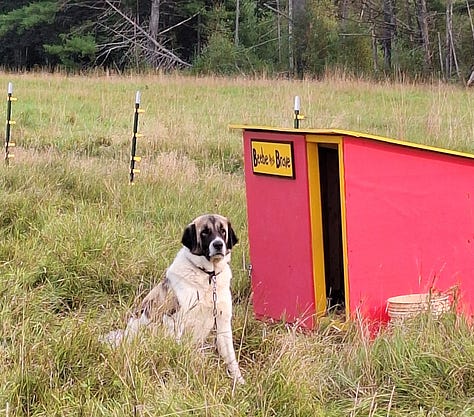
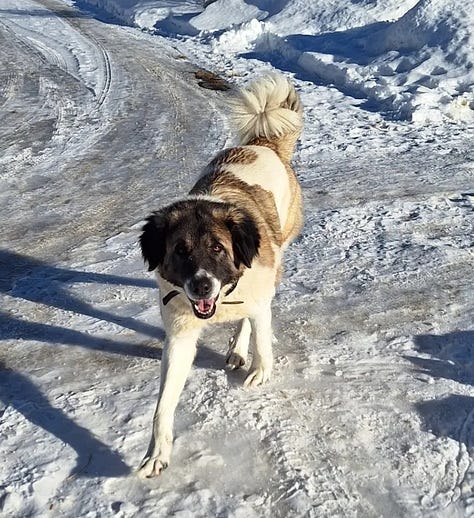
Considered an “extra-large” dog, she’s independent and clever─a magnificent animal. Yet, that intelligence also means she can be willful and overbearing at times. It took more than 2 years of patient training─nurturing a working-relationship with this dog built on mutual love, trust and respect─to turn Beebe into the working partner I have today.
It breaks my heart to have to tether her, but she leaps even my tallest fences─even the electric ones! With neighbors and a busy 2-lane highway nearby I worry for her safety if she were allowed to roam freely.
I have also yet to come up with the funds to get Beebe spayed, so there’s that, too. Since she eats a good 10-12 cups of food a day, feeding a pack of these dogs is not feasible for Runamuk. If you’d like to support the Runamuk Acres Conservation Farm and our mission of wildlife conservation through agriculture, please consider becoming a paid subscriber or make a one-time donation today.
Twice a day, when we’re doing our morning and afternoon livestock-chores, Beebe is released from duty. She’ll eat her massive meal, do her business, and play with Murphy (my 10yo black lab, all-around farm-dog and self-appointed companion animal) before I call her back to work.
Some livestock dogs stay inside the confines of their fences, while others do not. Beebe will stay inside my fences only so long as she wants to. Sometimes she’s content for days on end, while other times it’s not 20 minutes before she’s running free. I feel guilty for having to tether her, so whenever I am able Beebe gets released from work to “keep me company”.
During the growing season we spend an exorbitant amount of time on the field together. Regardless of the weather I’m on the field at least twice a day tending the animals, moving fences or mending them. These are treasured times for both of us.
Winter keeps us sequestered to the farmhouse. Lacking boots that provide enough protection for my feet on the more extreme cold days, field walks and woods tromping is limited this time of year. The dogs, too, get cold feet and chunks of ice and snow accumulate between their toes, making snowshoeing an uncomfortable adventure for them. We take advantage of milder days, but most of winter has us confined to the farmhouse and Beebe’s boredom mirrors my own.
Lambing Bin
Still, there’s plenty to be getting on with. Over the last week I’ve spent time assembling the “Lambing Bin” for the new babies we are expecting. Collecting my oldest and rattiest towels, the bulb syringe, thermometer, iodine, nutridrench, “just-in-case” syringes, and all of the supplies I will need when the first ewe goes into labor. Assembling everything in one spot in a storage bin, ready to go, to save myself the panic of having to hunt for things in a moment of need.
Thankfully, my finnsheep have proven to be hardy mothers and rarely need my presence for more than moral support. My job as farmer really begins after the birth, making sure new babies are cleaned and dried as quickly as possible. Ensuring they can find and are latching onto their mum’s teats for that all-important first feeding of colostrom. Watching to see that mum recovers well, too.
With such a small flock, every lamb in a precious and valuable asset. I’ll perform well-baby visits every 2 hours for the first 2-3 days. So long as they are eating regularly and with gusto, the new lambs will thrive. It’s when they’re too small and there’s too much competition at the udder that babies struggle, succumbing to the cold.
Lamb-Cam Update
Having met YouTube’s 50-subscriber benchmark last week (thank you to all those who’ve subscribed to my channel!), I spent a morning trying to connect the lamb-cam for live-streaming. When it did not go smoothly, I sacrificed a couple more of my early morning office sessions to troubleshoot the issue. But to no avail.
It may be that my security camera is too old or not compatible. Or it could just be my own ineptitude holding me back. A web-developer I am not, lol, though I’ve garnered enough technical capacity to grease the online-wheels for Runamuk.
I’ll reach out to my website designer (shout out to Emily Wolfe, if you need help with your business website, she’s your girl!) to see if she can see something I’m overlooking, but it may be a bust. In which case, I’ll simply share clips from the lamb-cam instead.
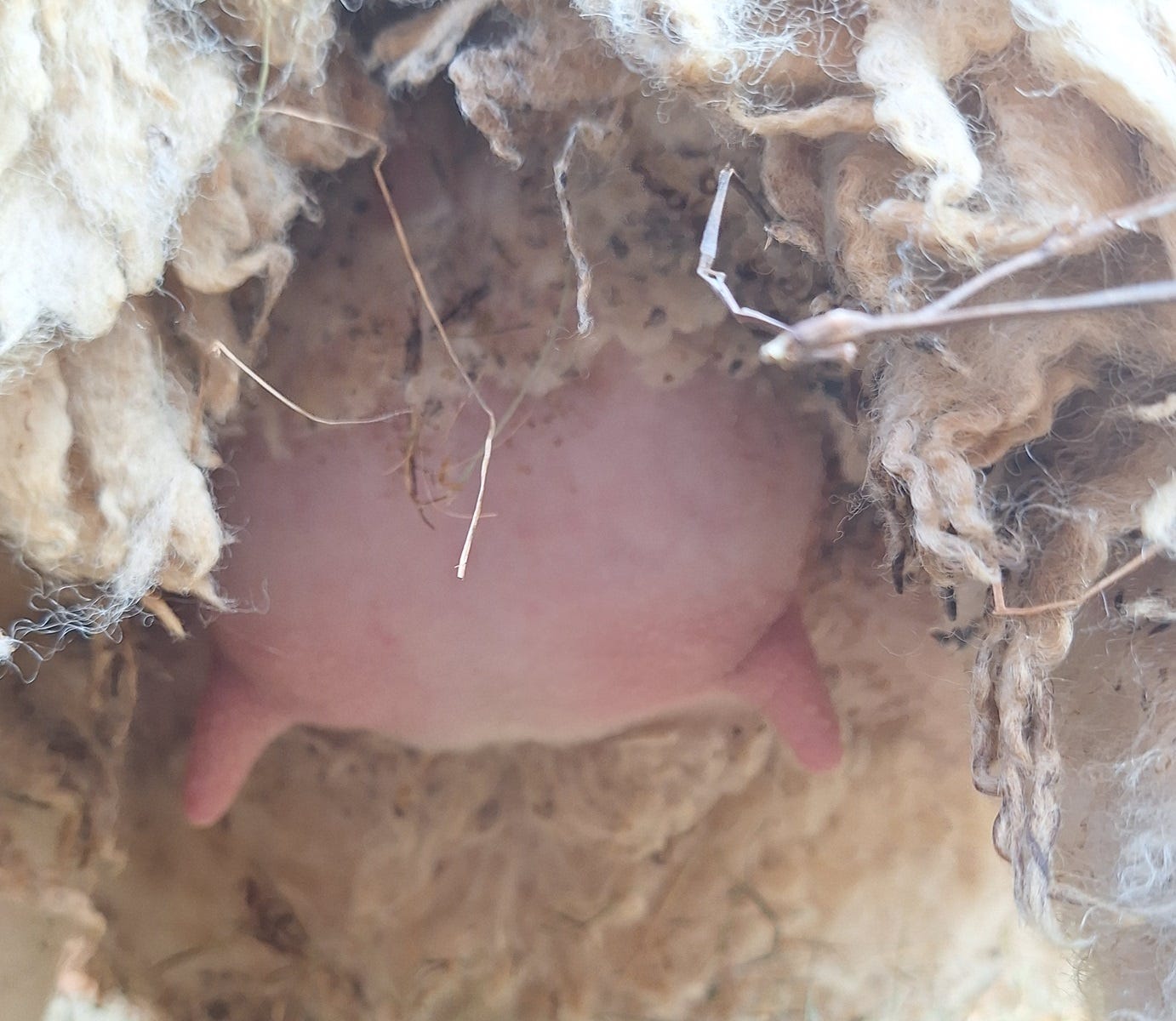
Another Round of Seeds
Every few days I’m sowing another round of seeds, setting the trays on heat mats in an orderly row. Last week I started kale and lettuces. They joined flats of onions, scallions, leeks, chamomile and oregano already growing under the propagation lights.
This week I’ll sow brassicas and lettuces into 6-packs to sell to locals come May. It’s a very small operation, but I’ve got it dialed in. From my “Propagation Room”, I’m producing some sexy-looking seedlings in a selection you won’t find at the box stores or even most greenhouses. I like to offer reliable hybrids, as well as tried-and-true heirloom varieties─and NO genetically modified plants. I’m very proud of my little farmstand, you know.
Farm-Smut
In the office, the plan was to publish a seed-starting tips-and-tricks article last week, but I found myself working on my novel instead. This is the thing that’s hard for me about creating a publishing schedule─when inspiration takes you in a different direction, your entire calendar is thrown off.
While the OCD organizer and planner in me cringes, I know it’s totally okay to allow my creative genius the freedom he needs. It’s okay to be flexible with my publishing schedule. And I very much want my first book under my belt, so─I’ve been running with that stream of creative energy, giving more time to developing my novel.
Long time readers might recall, however, for those who are new to my journey I will be brave and admit again that I also write romance stories. It’s a dirty little secret that I don’t like to talk about─Farmer Sam is a sappy romantic who swoons over a good love story.
The shame stems from the scorn and derision I’ve faced in the past when I’ve admitted my secret, I suppose. There is little respect for the romance industry, despite the fact that it’s one of the leading genres on the market. If I’m embracing my authentic self, however, this is something I have to do to live up to my full potential.
I call it “farm-smut”. Stories of sex and love on the Maine farm, homestead, or off-grid cabin, incorporating my love for Maine, nature, and my experience with the agrarian lifestyle. I have aspirations of doing a series of historical romance novels too, set in the Maine frontier during the Indian and Revolutionary Wars.
It’s too scary and too personal to share this writing with the world just yet. I’ve been giving it some thought, though, and I’d be willing to share a chapter at a time behind a paywall for feedback as I forge ahead with this project. That seems fairly safe, lol.
If this is something you’d be interested in reading and participating in, please leave a comment or subscribe today as a paid member to show your support!
Feeling Antsy
Meanwhile, Beebe gazed at me with a bored and somewhat sad expression as I bade her goodnight. I couldn’t help but laugh because I knew exactly how she felt.
“Are you ready to be back on the field, Beebe?” I asked her, humor and love coloring the tone of my voice.
Her ears perked up at the mention of the field and she looked at me with those intelligent brown eyes. Oh yes, she definitely knows that word.
Coming into the end of February now, we’re both ready to be back on the field. While I still marvel at the beauty of falling snow, and Beebe still revels in a good roll in the stuff, nothing quite beats those sessions on the field and that spring itch has us all feeling antsy.
I looked longingly to the field beyond the market garden and murmured, “Me too, girl. Me too.”
Much love to you and yours, my friends!
Your friendly neighborhood farmer,
Sam
Thank you for following along with the story of this lady-farmer! It is truly a privilege to live this life serving my family and community, and protecting wildlife through agricultural conservation. Check back soon for more updates from the farm, and be sure to follow @RunamukAcres on Instagram or Facebook!




